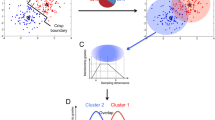Abstract
The study's major goal was to identify the most significant coccoliths based on foraminiferal species and fragment abundances, oxygen isotope ratios, and calculated temperatures. The degree of preservation of coccoliths and foraminifera indicates that the carbonate lysocline is between 3500 and 4000 m. The distribution of forty-four coccolithophore species in one hundred deep-sea core-tops from the southwest Indian Ocean is used. Gephyrocapsa oceanica has the strongest relationship with the foraminiferal fragments and carbonate. Calcidiscus leptoporus has the strongest influence on oxygen isotope and derived temperature. The findings could be useful in advancing paleoceanographic research.





Similar content being viewed by others
References
Jin X, Liu C, Zhang H (2018) Coccolith morphological and assemblage responses to dissolution in the recent sediments of the East China Sea. Mar Micropaleontol 152:101709
López-Otálvaro GE, Flores JA, Sierro FJ, Lalicata J, Lea DW, Mix A (2019) Deciphering latitudinal shifts in coccolith accumulation in the eastern tropical Pacific Ocean through the Pleistocene. Mar Micropaleontol 152:101739
Jakob I, Weggenmann F, Posten C (2018) Cultivation of Emiliania huxleyi for coccolith production. Algal Res 31:47–59
Jin X, Liu C (2017) Ecological and taphonomical influences on coccoliths in surface sediments in the shelf of the Yellow and East China Seas. Cont Shelf Res 140:27–36
Balch WM, Bowler BC, Drapeau DT, Lubelczy LC, Lyczkowski E, Mitchell C, Wyeth A (2019) Coccolithophore distributions of the north and South Atlantic ocean. Deep Sea Res Part I: Oceanogr Res Pap. https://doi.org/10.1016/j.dsr.2019.06.012
Jin P, Liu N, Gao K (2019) Physiological responses of a coccolithophore to multiple environmental drivers. Mar Pollut Bull 146:225–235
Priyadarshani WNC, Ran L, Wiesner MG, Chen J, Ling Z, Yu S, Ye Y (2019) Seasonal and interannual variability of coccolithophore flux in the northern South China Sea. Deep Sea Res Part I: Oceanogr Res Pap 145:13–30
Cavaleiro C, Voelker AH, Stoll H, Baumann KH, Kulhanek DK, Naafs BD, Kucera M (2018) Insolation forcing of coccolithophore productivity in the North Atlantic during the Middle Pleistocene. Quatern Sci Rev 191:318–336
Keuter S, Young JR, Frada MJ (2019) Life cycle association of the coccolithophore Syracosphaera gaarderae comb. nov. (ex Alveosphaera bimurata): taxonomy, ecology and evolutionary implications. Mar Micropaleontol 148:58–64
Krumhardt KM, Lovenduski NS, Iglesias-Rodriguez MD, Kleypas JA (2017) Coccolithophore growth and calcification in a changing ocean. Prog Oceanogr 159:276–295
Furukawa M, Sato T, Suzuki Y, Casareto BE, Hirabayashi S (2018) Numerical modelling of physiological and ecological impacts of ocean acidification on coccolithophores. J Mar Syst 182:12–30
Patil SM, Mohan R, Shetye SS, Gazi S, Baumann KH, Jafar S (2017) Biogeographic distribution of extant coccolithophores in the Indian sector of the Southern Ocean. Mar Micropaleontol 137:16–30
Li Y, Müller MN, Paull B, Nesterenko PN (2016) Precise and fast determination of inorganic magnesium in coccolithophore calcite. Chem Geol 437:1–6
Jang JS (1993) ANFIS: adaptive-network-based fuzzy inference system. IEEE Trans Syst Man Cybern 23(3):665–685
Petković D, Issa M, Pavlović ND, Pavlović NT, Zentner L (2012) Adaptive neuro-fuzzy estimation of conductive silicone rubber mechanical properties. Expert Syst Appl 39(10):9477–9482
Petković D, Ćojbašić Ž (2012) Adaptive neuro-fuzzy estimation of autonomic nervous system parameters effect on heart rate variability. Neural Comput Appl 21(8):2065–2070
Kurnaz S, Kaynak O, Konakoğlu E. (2007). Adaptive neuro-fuzzy inference system based autonomous flight control of unmanned air vehicles. In: International symposium on neural networks (pp. 14–21). Springer, Berlin
Petković D, Issa M, Pavlović ND, Zentner L, Ćojbašić Ž (2012) Adaptive neuro fuzzy controller for adaptive compliant robotic gripper. Expert Syst Appl 39(18):13295–13304
Fincham MJ, Winter A (1989) Paleoceanographic interpretations of coccoliths and oxygen-isotopes from the sediment surface of the southwest Indian Ocean. Mar Micropaleontol 13(4):325–351
Author information
Authors and Affiliations
Corresponding author
Additional information
Publisher's Note
Springer Nature remains neutral with regard to jurisdictional claims in published maps and institutional affiliations.
Rights and permissions
About this article
Cite this article
Karanikić, P., Milovančević, M. Neuro-fuzzy estimation of important coccoliths on abundances of foraminiferal species and fragments abundances. J Radioanal Nucl Chem 330, 1037–1043 (2021). https://doi.org/10.1007/s10967-021-08044-9
Received:
Accepted:
Published:
Issue Date:
DOI: https://doi.org/10.1007/s10967-021-08044-9




